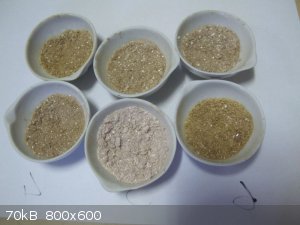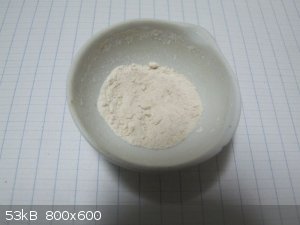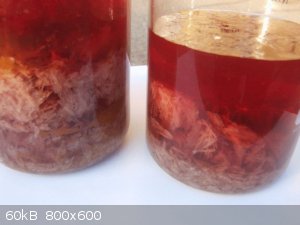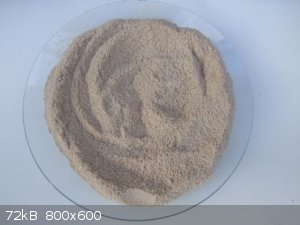Pumukli
National Hazard
   
Posts: 686
Registered: 2-3-2014
Location: EU
Member Is Offline
Mood: No Mood
|
|
Preparation of Acetanilide
Acetanilide - with a twist
The classic reaction, preparation of acetanilide from aniline and acetic anhydride
was part of the curriculum in preparative organic chemistry laboratories for students, practically all around the world until recently. Now it is
phased out gradually due to the concerns regarding the unhealthy nature of aniline.
Anyway, for us, amateur chemists, preparation of acetanilide can be a rewarding experience.
First of all, one of its parents, aniline [1] can be prepared from OTC reagents [2].
The tricky part is the acetic anhydride [3],[4] because it is not only non-OTC, it is a watched chemical in most
jurisdictions. It would be nice if we could get along without using it, wouldn’t it?
Well, I came across a unusual lab recipe [5] which simply said „Aniline is refluxed with glacial acetic acid in the presence of
fused sodium acetate when acetanilide is obtained.”
(Also, the method is not new, a russian chemist (N. Menschutkin) reportedly studied this reaction almost 140 years ago in St. Petersburg
[6]. He used closed „bomb tubes” as many chemists did in the old days to achieve higher temperatures.)
Hmm, no need for anhydride? Sounds good!
I tried the method but was lazy to properly prepare anhydrous sodium acetate. Simply sprinkled some anhydrous sodium carbonate into some 96% percent
acetic acid, a few mililitres of aniline was also mixed in and refluxed the mixture for a few hours. Upon cooling the mixture and diluting it with
cold water a good crop of crystals formed! Whoa! I got acetanilide! :-)
Then the „greedy amateur” mentality clicked in and I started a little systematic search for the sweetest spot of this reaction. (Sweetest in this
case means simplest method with highest yield on the cheap.)
Experimental:
In all cases I used a 50 ml round bottom flask for the reaction, equipped with a reflux condenser and a 4x12 mm teflon coated stir bar for the
stirring. Stirring was always on, at around 700 round/min speed. The reflux condenser was dried between each run to avoid the dilution of the reaction
mixture by droplets condensed on the surface of the glass. At the top of the condenser there was a 2 m long plastic tube attached but otherwise it was
not closed by a calcium-chloride tube or anything like that. I thought air humidity would not cause serious errors because the weather / room
temperature was practically the same during these trials.
I used the same, unpurified aniline for all reactions, reddish liquid, straight from the bottle. The acetic acid I have is not glacial, only 96%. My
„acetic anhydride” is 50 years old (based on a sequence of digits at the edge of its label) :-) Unknown concentration, probably very dilute.
Boric acid, Macrogolum-400 and CaCl2 was all good quality fresh reagents.
All the experiments went like this:
I measured (precisely measured amount) of 2,95 - 3,09 g aniline into the 50 ml flask and added 10 ml 96% acetic acid. (In the boric acid experiments I
added 100 mg boric acid or 100 mg boric acid and 100 mg Macrogolum-400 [7] in the other case. In the anhidride experiments at first I
mixed either 9 ml 96% acetic acid and 1 ml acetic anhidride or 8 ml acid and 2 ml anhidride and refluxed the acid with anhidride for an hour, then let
it cool to room temperature before I added the measured amount of aniline. This way always 3 g aniline and 10 ml acetic acid was used.)
When the reaction mixture was ready, I attached the reflux condenser, turned on the heating (hot plate temperature was always set to 200 C), stirrer
on, and let the reaction run for either 4.5 or 8.5 hours. After the predetermined time the heating was turned off, but the stirring not, and the flask
with condenser was raised a few centimetres above the hotplate to achieve quicker cooling. When the mixture was cold (usually next morning), 60 ml
cold water was introduced and it caused immediate crystallisation of the product. In the „saturated” cases saturated, cold, filtered acetanilide
solution was used for the precipitation. Solubility of acetanilide in water at 10 C is roughly 4.4g/l. Then the flask was lowered to the hotplate
again, temperature set to 140 C and heating turned on again. Within 30 minutes the reaction mixture was gently refluxing and the crystals dissolved.
Then I dismantled the equipment while hot and poured the content of the flask (including stir bar) into a 100 ml beaker and left it uncovered to cool
and crystallize for several hours (room temp: 7 C). The contents of the beaker was vacuum filtered on a glass filter funnel but I put a layer of
filter paper on top of the glass fritt. (I dont really like scraping with my steel tool the fritt directly.) The crude acetanilide was washed with
either cold water or acetanilide saturated cold water 2 times in every case. (10-10 ml liquid was used for the washing.) The solids were resuspended,
thoroughly mixed with the washing liquid and filtered again. The washed product was collected in preweighed small porcelain dishes and dried on a
hotplate around 100 C for an hour, until constant weight was achieved. (The stir bar was carefully removed and cleaned before drying.)
Results:
1. Aniline: 2.95 g Time: 4 hours Acetanilide: 3.20 g Yield: 75%
2. Aniline: 2.97 g Boric acid: 100 mg (5mol%) Time: 4 hours Acetanilide: 3.28g Yield: ~75%
3. Aniline: 2.99 g Boric acid + Macrogolum Time: 4 hours Acetanilide: 3.46g Yield: 79.7%
4. Aniline: 2.98 g CaCl2: 6.07 g Time: 4 hours Acetanilide: 0 g Yield: 0%
5. Aniline: 2.96 g Acid: 9+1 ml Time: 4 hours Acetanilide: 3.29 g Yield: 76.5%
6. Aniline: 3.02 g Acid: 8+2 ml Time: 4 hours Acetanilide: 3.56 g Yield: 81.2%
7. Aniline: 3.03g Time: 8 hours Acetanilide: 3.73 g Yield: 84.7%
8. Aniline: 3.09 g Acid: 8+2 ml Time: 8 hours Acetanilide: 3.69 g Yield: 82.2%
9. Aniline: 2.98 g Time: 8 hours Saturated Acetanilide: 3.95g Yield: 91.2%
10. Aniline: 3.01g Acid: 8+2 ml Time: 8 hours Saturated Acetanilide: 3.84g Yield: 87.8%

End products of the first six runs.
Discussion:
In general, aniline can be successfully N-acetylated by acetic acid with good to excellent yields.
Not even anhydrous sodium-acetate is required.
Even 96% acetic acid alone can do the job, though glacial is best.
Catalysts (e.g. boric acid + Macrogolum-400) can be used and can contribute to enhanced yield but playing with reaction time and/or acid concentration
seems easier and more amateur friendly.
50 years old acetic anhydride is probably just concentrated acetic acid if at all by now.
Crashing out and washing the crude acetanilide with saturated acetanilide solution can make a remarkable (positive) difference in the final yield.
Yes, it is sort of a cheating. :-)
Although the product looks bad (see picture, color is anything but white), the melting point of the mixed crudes is in the range of 109.4 – 114.4 C.
Mixing 2 g „mixed crudes” with 125 mg decolorising carbon in 10 ml denatured ethanol, then boiling it gently for 2-3 minutes and filtering gives a
much less colored (pinkish orange) liquid. By evaporating the solvent I could recover 1. 97 g purified acetanilide. (1.5% loss) The melting point is
improved, now in the range of 113.9 – 116.7 C. After a second such treatment the color is improved a bit further but is still not white. The melting
point range is practically the same, 114,0 – 116,0 C in this case.

The purified product.
Based on the success of the trials I repeated the synthesis on a 20-fold scale (60,30 g aniline, 200 ml 96% acetic acid, 8 hours reflux). The result:
73.94 g crude acetanilide, 84.4% yield, mp: 109.9-115.1 C. Probably a few more grams of acetanilide coud have been recovered by concentrating the
mother liquor (approx. 1400 ml, solubility of acetanilide is higher in acetic acid solutions than in pure water.)
All in all, achieving a 90-92% yield is not unrealistic by this simple technique.
 
Pictures of the big batch.
Literature:
1. https://en.wikipedia.org/wiki/Aniline
2. https://www.sciencemadness.org/whisper/viewthread.php?tid=42...
3. https://www.sciencemadness.org/whisper/viewthread.php?tid=9
4. https://en.wikipedia.org/wiki/Acetic_anhydride
5. https://www.stansacademy.com/preparation-acetanilide-aniline...
6. Chemische Berichte article by Menschutkin from the 1880-ies, forgot the doi, but here’s the saved file: Attachment: menshutkinanilide.pdf (274kB)
This file has been downloaded 451 times
7. Discussion Addendum for:
Boric Acid Catalyzed Amide Formation from Carboxylic Acids
and Amines: n-Benzyl-4-phenylbutyramide
Original article: Tang, P. W. Org. Synth. 2005, 81, 262.
DOI:10.15227/orgsyn.089.0432
Attachment: v89p0432.pdf (933kB)
This file has been downloaded 490 times
[Edited on 18-1-2021 by Pumukli]
|
|
|
arkoma
Redneck Overlord
      
Posts: 1761
Registered: 3-2-2014
Location: On a Big Blue Marble hurtling through space
Member Is Offline
Mood: украї́нська
|
|
The link to reference (2) ain't working 
"We believe the knowledge and cultural heritage of mankind should be accessible to all people around the world, regardless of their wealth, social
status, nationality, citizenship, etc" z-lib
|
|
|
Pumukli
National Hazard
   
Posts: 686
Registered: 2-3-2014
Location: EU
Member Is Offline
Mood: No Mood
|
|
Strange. It works for me. Tried via https and plain http login as well.
|
|
|
Boffis
International Hazard
    
Posts: 1836
Registered: 1-5-2011
Member Is Offline
Mood: No Mood
|
|
Very interesting Pumukli and another good write up.
Which reactions contained the "anhydride"? Is it the ones where you have shown the acid as 8+2 or 9+1? By the way I have found that very old acetic
anhydride can be perfectly good if it has been stored in tightly closed bottles.
Also what is Macrogolum 400? and in experiments 9 and 10 what do you mean by "saturated acetanilide"?
|
|
|
Pumukli
National Hazard
   
Posts: 686
Registered: 2-3-2014
Location: EU
Member Is Offline
Mood: No Mood
|
|
Yes, you are right, the 9+1 and 8+2 examples are the ones where I used some acetic anhydride to "fortify" my acid. The intention was just to make it
closer to 99.5% acetic acid from the starting 96% because the goal was to not use ahydride at all. I wanted to explore the possibilities of using more
concentrated acid and this was the way I attempted reaching it.
E.g. 9+1 means 9 ml 96% acid and 1 ml anhydride, boiled together for an hour and cooled to room temp before mixing in the aniline.
I realised that my bottle was not airtight... And during the last days of the experiment almost the whole content of the anydride bottle solidified to
"ice". I interpret this as evidence that the anhydride was practically gone...
Macrogolum-400 is a polyoxiethylene-glycol used as an emulgeator in cosmetics, drug formulations, etc. I have a reference in which it was used in
combination with boric acid to enhance the yields of amidations - which reference I forgot to list in the literature section. I'll correct it, it is
an interesting paper. In a nutshell: the high bp poly-glycol makes non-volatile boric esters in situ and these esters are the catalysators of the
amidations. One experiment is not a real experiment but it did show an improved yield in this case too.
Saturated acetanilide: I used cold, saturated, filtered acetanilide solution in the precipitation and washing of crude acetanilide instead of pure,
cold, deionized water. I don't have a rotovap and did not feel like spending hours with evaporating dilute acetic acid to dryness in order to get the
last bits of formed acetanilide from the reaction mixture. It just shows that there's more in the mother liquor if one wants to fiddle with it and the
reaction probably goes to near completion or close to theoretical yields but the non-zero solubility of the product makes it impossible to squeeze the
last milligrams from the broth.
|
|
|
Fery
National Hazard
   
Posts: 990
Registered: 27-8-2019
Location: Czechoslovakia
Member Is Online
|
|
Pumukli, thank you very much for your excellent work and detailed description !!!
Very good yields !!!
Did you try "green" route from aniline + acetic acid + Zn dust / Fe powder which does not require acetic anhydride?
https://youtu.be/d6YE-Xxf1Ac?t=129
https://sci-hub.st/10.1021/acs.jchemed.6b00749
|
|
|
Pumukli
National Hazard
   
Posts: 686
Registered: 2-3-2014
Location: EU
Member Is Offline
Mood: No Mood
|
|
Thanks! :-)
I'm aware of that zinc-dust method but when I realised that plain acetic acid could yield what I wanted I felt less inclined to try it.
|
|
|
Fery
National Hazard
   
Posts: 990
Registered: 27-8-2019
Location: Czechoslovakia
Member Is Online
|
|
Hi Pumukli, yes, better not to mess with additional things when there is no need to do it.
I wonder whether the water produced in the reaction couldn't be driven out using hexane and Dean-Stark trap apparatus as it is very convenient in
Fisher esterification? If yes you could achieve almost quantitative yield. Very probably that would require slightly more acetic acid as I presume
there is also azeotrope of acetic acid + hexane and perhaps even ternary azeotrope water + acetic acid + hexane
|
|
|
|